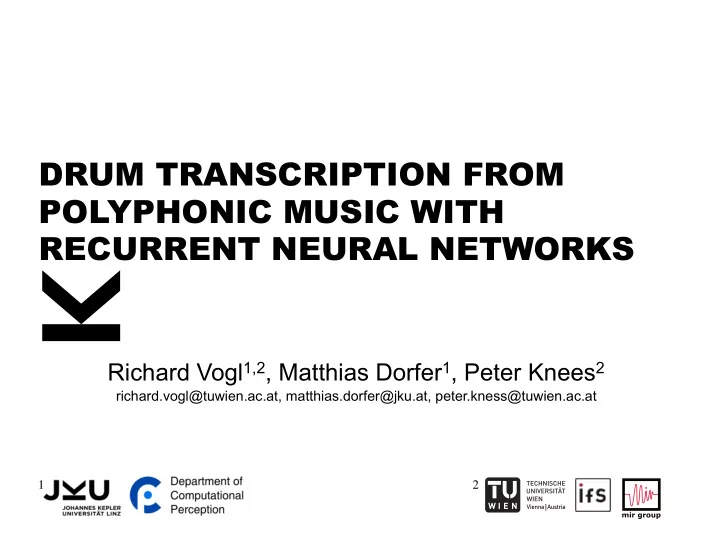

DRUM TRANSCRIPTION FROM POLYPHONIC MUSIC WITH RECURRENT NEURAL NETWORKS Richard Vogl 1,2 , Matthias Dorfer 1 , Peter Knees 2 richard.vogl@tuwien.ac.at, matthias.dorfer@jku.at, peter.kness@tuwien.ac.at 1 2
INTRODUCTION • Goal: model for drum note detection in polyphonic music - In: Western popular music containing drums - Out: Symbolic representation of notes played by drum instruments • Focus on three major drum instruments : snare, bass drum, hi-hat 2
INTRODUCTION • Wide range of applications - Sheet music generation - Re-synthesis for music production - Higher level MIR tasks 3
SYSTEM ARCHITECTURE RNN peak signal feature extraction picking preprocessing event detection classification audio events RNN training 4
ADVANTAGES OF RNNS • Relatively easy to fit large and diverse datasets • Once trained, computational complexity of transcription relatively low • Online capable • Generalize well • Easy to adapt to new data • End-to-end: learn features, event detection, and classification at once • Scale better with number of instruments (rank problem in NMF) • Trending topic: lots of theoretical work to benefit from 5
DATA PREPARATION RNN SP PP • Signal preprocessing - Log magnitude spectrogram @ 100Hz - Log frequency scale, 84 frequency bins - Additionally 1st order differential - 168 value input vector for RNN 6
DATA PREPARATION RNN SP PP • Signal preprocessing - Log magnitude spectrogram @ 100Hz - Log frequency scale, 84 frequency bins - Additionally 1st order differential - 168 value input vector for RNN • RNN targets - Annotations from training examples - Target vectors @ 100Hz frame rate 6
RNN ARCHITECTURE RNN SP PP • Two layers containing 50 GRU s each - Recurrent connections • Output: dense layer with three sigmoid units - No softmax: events are independent - Value represent certainty/pseudo-probability of drum onset - Does not model intensity/velocity 7
PEAK PICKING RNN SP PP Select onsets at position n in activation function F(n) if: [Böck et. al 2012] 8
RNN TRAINING • Backpropagation through time ( BPTT ) • Unfold RNN in time for training [Olah 2015] • Loss ( ℒ ): mean cross-entropy between output ( ŷ n ) and targets (y n ) for each instrument • Mean over instruments with different weighting (w i ) per instrument (~+3% f-measure) • Update model parameters ( 𝜾 ) using gradient ( ) calculated on mini-batch and learn rate ( 𝜃 ) 9
RNN TRAINING (2) • RMSprop - uses weight for learn rate based on moving mean squared gradient E[ 2 ] • Data augmentation - Random transformations of training samples (pitch shift, time stretch) • Drop-out - Randomly disable connections between second GRU layer and dense layer • Label time shift instead of BDRNN 10
SYSTEM ARCHITECTURE RNN peak signal feature extraction picking preprocessing event detection classification audio events RNN training 11
DATA / EVALUATION • IDMT-SMT-Drums [Dittmar and Gärtner 2014] - Three classes (Real, Techno, and Wave / recorded/synthesized/ sampled) - 95 simple solo drum tracks (30sec), plus training and single instrument tracks • ENST-Drums [Gillet and Richard 2006] - Drum recordings, three drummers on three different drum kits - ~75 min per drummer, training, solo tracks plus accompaniment • Precision, Recall, F-measure for drum note onsets • Tolerance: 20ms 12
EXPERIMENTS • SMT optimized - Six fold cross-validation on randomized split of solo drum tracks • SMT solo - Three fold cross-validation on different types of solo drum tracks • ENST solo - Three fold cross-validation on solo drum tracks of different drummers / drum kits • ENST accompanied - Three fold cross-validation on tracks with accompaniment 13
RESULTS Method SMT opt. SMT solo ENST solo ENST acc. NMF-SAB 95.0 — — — [Dittmar and Gärtner 2014] PFNMF — 81.6 77.9 72.2 [Wu and Lerch 2015] HMM — — 81.5 74.7 [Paulus and Klapuri 2009] BDRNN 96.1 83.3 73.2 66.9 [Southall et al. 2016] tsRNN 96.6 92.5 83.3 75.0 𝜀 = 0.10 𝜀 = 0.15 𝜀 = 0.15 𝜀 = 0.10 14
RESULTS Method SMT opt. SMT solo ENST solo ENST acc. NMF-SAB 95.0 — — — [Dittmar and Gärtner 2014] PFNMF — 81.6 77.9 72.2 [Wu and Lerch 2015] HMM — — 81.5 74.7 [Paulus and Klapuri 2009] BDRNN 96.1 83.3 73.2 66.9 [Southall et al. 2016] tsRNN 96.6 92.5 83.3 75.0 𝜀 = 0.10 𝜀 = 0.15 𝜀 = 0.15 𝜀 = 0.10 14
RESULTS Method SMT opt. SMT solo ENST solo ENST acc. NMF-SAB 95.0 — — — [Dittmar and Gärtner 2014] PFNMF — 81.6 77.9 72.2 [Wu and Lerch 2015] HMM — — 81.5 74.7 [Paulus and Klapuri 2009] BDRNN 96.1 83.3 73.2 66.9 [Southall et al. 2016] tsRNN 96.6 92.5 83.3 75.0 𝜀 = 0.10 𝜀 = 0.15 𝜀 = 0.15 𝜀 = 0.10 14
RESULTS Method SMT opt. SMT solo ENST solo ENST acc. NMF-SAB 95.0 — — — [Dittmar and Gärtner 2014] PFNMF — 81.6 77.9 72.2 [Wu and Lerch 2015] HMM — — 81.5 74.7 [Paulus and Klapuri 2009] BDRNN 96.1 83.3 73.2 66.9 [Southall et al. 2016] tsRNN 96.6 92.5 83.3 75.0 𝜀 = 0.10 𝜀 = 0.15 𝜀 = 0.15 𝜀 = 0.10 14
RESULTS 15
Input GRU1 GRU2 Output Targets Time -> 16
Input GRU1 GRU2 Output Targets Time -> 16
Input GRU1 GRU2 Output Targets Time -> 16
CONCLUSIONS • Towards a generic end-to-end acoustic model for drum detection using RNN s • Data augmentation greatly improves generalization • Weighting loss functions helps to improve detection of difficult instruments • RNNs with label time shift perform equal to BDRNN • Simple RNN architecture performs better or similarly well as handcrafted techniques while using a smaller tolerance window (20ms) 17
Recommend
More recommend